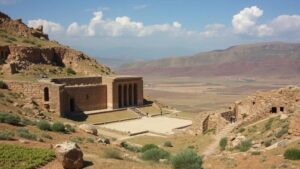Exploring the purpose and creators of the “Desert Kites,” massive hunting structures.
Exploring the Purpose and Creators of the Desert Kites
The Desert Kites are remarkable prehistoric hunting structures found primarily across the arid landscapes of the Middle East, specifically in regions such as Jordan, Syria, and northern Saudi Arabia. These large-scale constructions date back to the Neolithic period, around 8000 to 3000 BCE, and serve as a fascinating testament to the ingenuity of early human societies in adapting to their environment. This article delves into the origins, purpose, and creators of these enigmatic structures.
What Are Desert Kites?
Desert Kites are characterized by their unique kite-like shape, formed by a series of stone walls that converge into a narrow funnel leading to a killing area. structures often measure several hundred meters in length and can be up to 6 meters wide. The design is thought to enable hunters to drive herds of game, such as gazelles, into the confined space for easy capture.
- The walls of the kites are typically constructed from piled stones, sometimes going back to 5,000 years.
- The funnel shape is specifically designed to guide the animals into a smaller area, maximizing the chances of a successful hunt.
Historical Context and Origin
Archaeologists have identified over 1,000 Desert Kites across the Levant, particularly in countries like Jordan, with notable concentrations in the eastern deserts. The usage of these structures is closely associated with the lifestyle and subsistence strategies of prehistoric groups who inhabited these regions. evidence suggests that these hunting strategies were crucial for communities that relied heavily on game hunting for sustenance.
The term Desert Kite was coined in the early 20th century when British archaeologist David M. E. D. St. John published his findings on these structures. Since then, numerous studies have reinforced their significance in understanding ancient hunting techniques.
The Purpose of Desert Kites
The primary purpose of Desert Kites was to facilitate the hunting of migrating game animals. By constructing these structures, prehistoric peoples could effectively manage and capture animal populations in an efficient manner. The design illustrates a sophisticated understanding of animal behavior and the topography of the areas in which they hunted.
- They allowed for cooperative hunting methods, where groups of hunters could work together to drive animals into the killing zones.
- The limited access to the funnel created a bottleneck effect, significantly increasing the odds of successfully capturing prey.
Creators of the Desert Kites
Although the specific groups responsible for constructing Desert Kites remain difficult to ascertain, archaeological evidence suggests they were likely made by early pastoral and hunter-gatherer societies. These groups were adept at using the landscape to their advantage, demonstrating a significant degree of social organization.
For example, the creators might have included community members from the Natufian culture, who were among the first to adopt a sedentary lifestyle and develop structured hunting strategies. collaborative efforts required to construct and effectively use these kites imply a well-organized social structure with defined roles and knowledge-sharing among community members.
Real-World Applications and Modern Significance
Desert Kites serve not only as a means for understanding prehistoric hunting practices but also as a reminder of how human ingenuity adapts to environmental challenges. The techniques and methods applied by early societies can still inspire contemporary wildlife management and conservation strategies. By understanding past human interactions with ecosystems, modern conservationists can better assess how to maintain biodiversity and manage natural resources sustainably.
Conclusion
The Desert Kites stand as monumental reminders of human ingenuity during the Neolithic era. e structures reveal the advanced techniques employed by our ancestors to harness their environment and ensure survival. As we continue to explore the significance of these ancient hunting installations, they offer crucial insights into the lifestyle, social structures, and adaptive strategies of prehistoric cultures. Understanding their purpose not only enriches our historical narrative, but it also provides lessons applicable to contemporary practices in wildlife management and sustainability.

